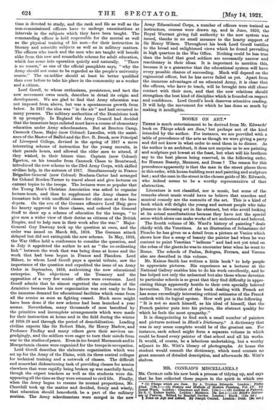BOOKS ON ART.•
THERE is much entertainment to be derived from Mr. Edwards' book on Things which are Seen,° but perhaps not of the kind intended by the author. For instance, we are provided with a table of precedence of the arts as though we were giving a party and did not know in what order to send them in to dinner. As the author is an architect, it does not surprise us to see painting
and sculpture put lowest at the feast, but what will his brethren say to the best places being reserved, in the following order, for Human Beauty, Manners, and Dress ? The reason for this precedence'apparently is that the man in the street places them in this order, with house-building next and painting and sculpture last ; and the man in the street is the chosen guide of Mr. Edwards, who indeed seems to be a worthy representative of that abstraction.
Literature is not classified, nor is music, but some of the remarks about music would have us believe that marches and musical comedy are the summits of the art. This is a kind of book which will delight the young and earnest people who take pleasure in discussing art in the abstract, but who avoid looking at its actual manifestations because they have not the special sense which alone can make works of art understood and beloved.
The fourth volume of Mr. Ward's history of painting deals chiefly with the Venetians. As an illustration of Sebastiano del Piombo he has given us a detail from a picture at Venice which shows how fine a scamp of beauty the painter had when he was content to paint Venetian " bellezze " and had not yet tried on the robes of the giants he was to encounter later when he went to Rome. The schools of Padua, Bologna, Ferrara, and Verona also are described in this volume.
Mr. Kaines Smith has written a little book 3 to help people to appreciate pictures. His experience as a lecturer at the National Gallery enables him to do his work excellently, and he has helped not only the unlearned but also those whose devotion to particular schools is so great that they find difficulty in appre- ciating things apparently hostile to their own specially beloved favourites. The section of the book dealing with. French art has some exceedingly interesting critical estimates of the Frenct outlook with its logical egoism. How well put is the following " It is not so much himself, as his ideal of himself, that the French painter puts into his picture, the abstract quality for which he feels the most sympathy."
It is disappointing to find such a small number' of painters
and pictures noticed in Black's Dictionary.' A dictionary that was in any sense complete would be of the greatest use. For instance, each school might form a separate volume in which could be found every painter of that school and all his works. It would, of course, be a laborious undertaking, but a worthy adjunct to Mr. Witt's library of photographs. At home the student would consult the dictionary, which need contain no great amount of detailed description, and afterwards Mr. Witt's shelves.


































 Previous page
Previous page